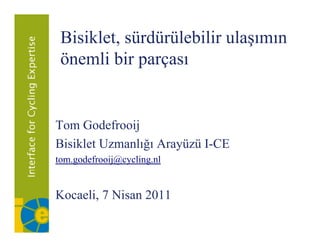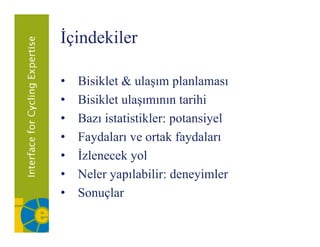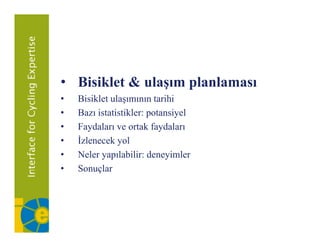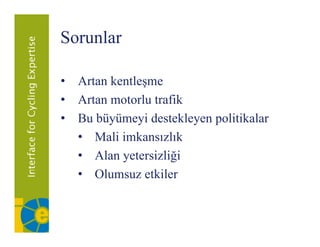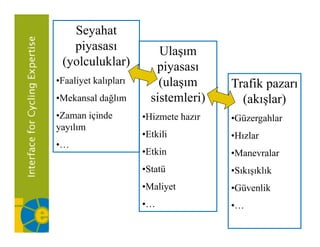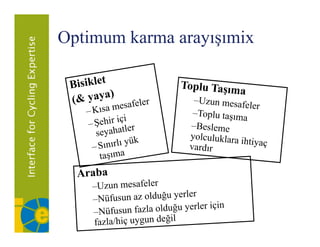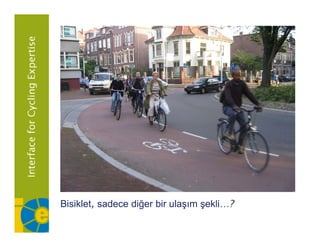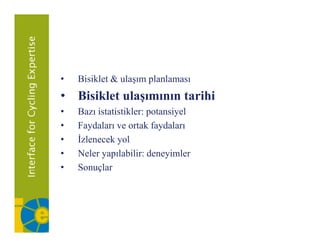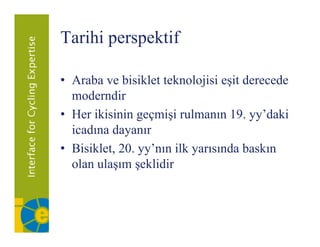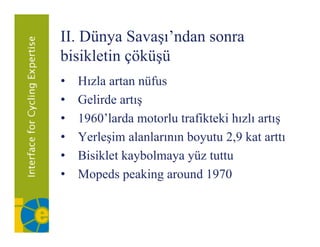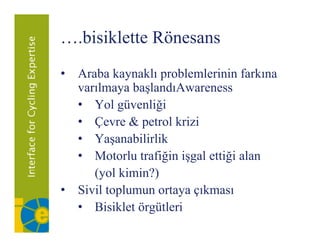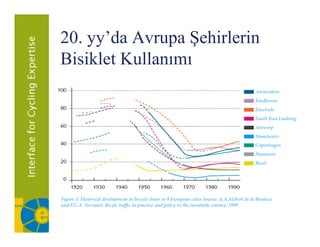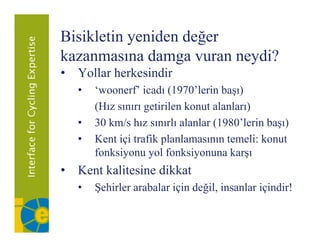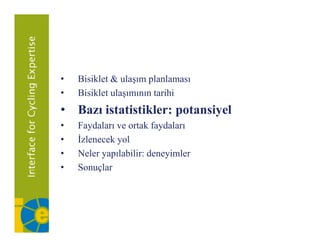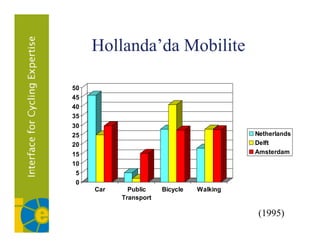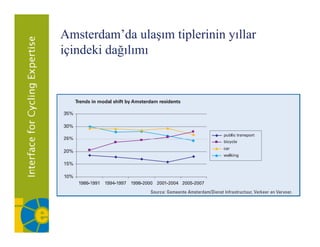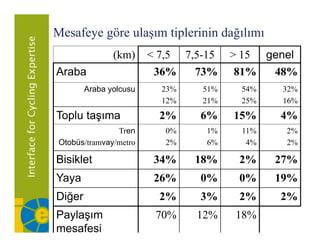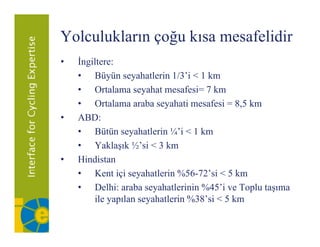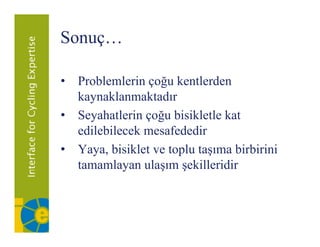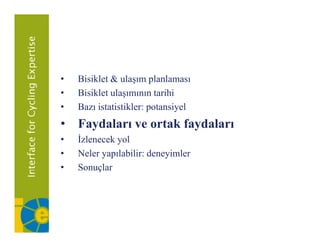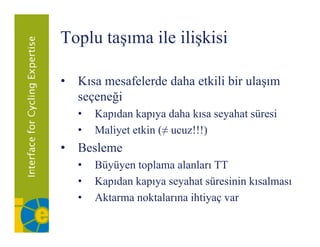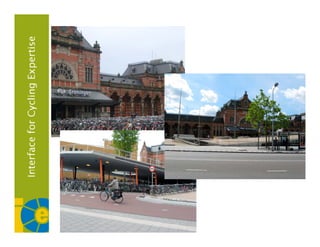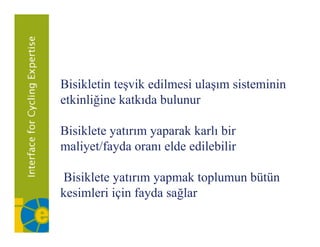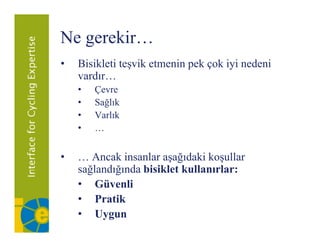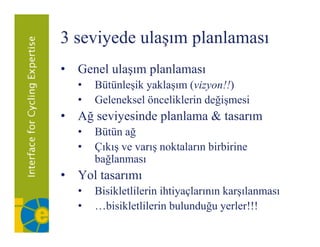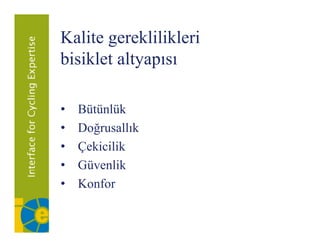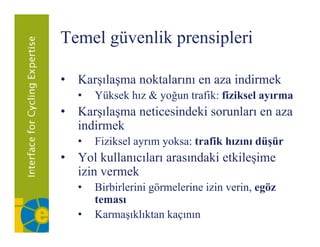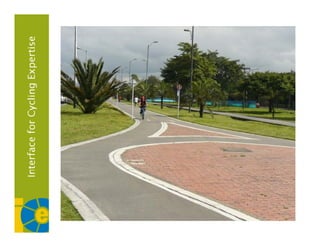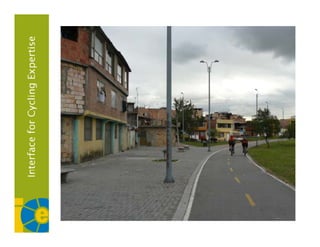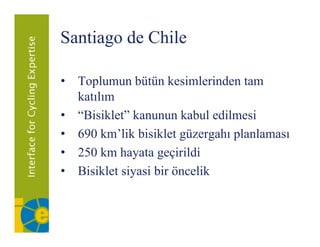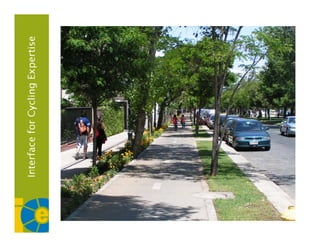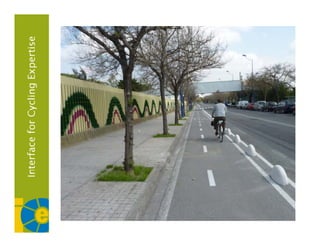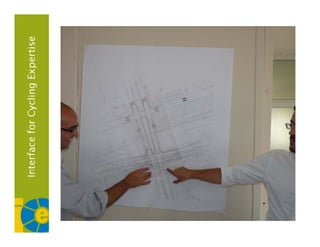Bisiklet: SĂŒrdĂŒrĂŒlebilir UlaĆımın Ănemli Bir Parçası
- 1. Bisiklet, sĂŒrdĂŒrĂŒlebilir ulaĆımın , Ć Ă¶nemli bir parçası Tom Godefrooij Bisiklet UzmanlıÄı ArayĂŒzĂŒ I-CE i ikl l tom.godefrooij@cycling.nl Kocaeli, 7 Nisan 2011
- 2. İçindekiler ç âą Bisiklet Bi ikl & ulaĆım planlaması l l l âą Bisiklet ulaĆımının tarihi âą Bazı istatistikler: potansiyel âą Faydaları ve ortak faydaları âą Ä°zlenecek yol âą Neler N l yapılabilir: d l bili deneyimler i l âą ł§ŽÇČÔłÜç±ôČč°ù
- 3. âą Bisiklet & ulaĆım planlaması âą Bisiklet ulaĆımının tarihi âą Bazı istatistikler: potansiyel âą Faydaları ve ortak faydaları âą Ä°zlenecek yol Ä° l k l âą Neler yapılabilir: deneyimler âą ł§ŽÇČÔłÜç±ôČč°ù
- 4. Sorunlar âą A Artan k l kentleĆme âą Artan motorlu trafik âą Bu bĂŒyĂŒmeyi destekleyen politikalar âą Mali imkansızlık âą Alan yetersizliÄi âą Ol Olumsuz etkiler kil
- 5. UlaĆım nedir? Ć Hareketlilik, H k lilik seyahat, ulaĆım, eriĆim⊠h l ii âą Kalite â fazla km ve yĂŒksek hız âą Kalite: mobilitenin katılımcılıÄa ne kadar olanak saÄladıÄı ile ilgilidir âą UlaĆım ve mobilite: faaliyetin mĂŒmkĂŒn kılınması kl
- 6. Seyahat piyasası UlaĆım (yolculuklar) piyasası âąFaaliyet kalıpları (ulaĆım Trafik pazarı âąMekansal daÄlım sistemleri) (akıĆlar) âąZaman içinde âąHizmete hazır âąGĂŒzergahlar yayılım âąEtkili âąHızlar âąâŠ âąEtkin âąManevralar âąStatĂŒ StatĂŒ âąSıkıĆıklık âąMaliyet âąGĂŒvenlik âąâŠ âąâŠ
- 7. UlaĆım planlaması âą UlaĆım ihtiyaçlarını karĆılamak âą Bireyler & toplum âą UlaĆımın sosyal ve ekonomik refaha katkısını en yĂŒkseÄe taĆımak âą Olumsuz etkileri en aza indirmek âą Yol gĂŒvenliÄi âą YaĆanabilirlik âą Ăevre âą Ä°klim âą âŠ
- 8. Taktik hedefler âą Seyahat piyasasının hedefleri âą Seyahat ihtiyacını en aza indirmek âą UlaĆım piyasasının hedefleri âą MĂŒmkĂŒn olan en iyi ulaĆım Ćeklini seçmek âą Kısa mesafelerde: Bisiklet ve Yaya y âą Uzun mesafelerde: Toplu TaĆıma âą Trafik piyasasının hedefleri âą Yeterli yol tasarımı, bisiklet yolları dahil
- 9. Farklı ulaĆım Ćekillerinin rolĂŒ âą GĂŒĂ§lĂŒ ve zayıf yönlerin incelenmesi âą UlaĆım tiplerinin deÄerlendirilmesi/ Ć p Ä ulaĆım tiplerine göre ulaĆım sistemleri âą Ărn. GĂŒĂ§lĂŒ yönleri kullanın âą Sorunlu kullanımlar için alternatif sunmak âą Seyahat için uygun deÄil âą Toplum için çok fazla olumsuz etki
- 10. Optimum karma arayıĆımix p yĆ
- 11. Bisiklet, d kli ? Bi ikl t sadece diÄ bir ulaĆım ĆekliâŠ? diÄer bi l
- 12. âą Bisiklet Bi ikl t & ulaĆım planlaması l l l âą Bisiklet ulaĆımının tarihi âą Bazı i i ikl potansiyel istatistikler: i l âą Faydaları ve ortak faydaları âą Ä°zlenecek yol âą Neler yapılabilir: deneyimler âą ł§ŽÇČÔłÜç±ôČč°ù
- 13. Tarihi perspektif p p âą A b ve bi ikl t teknolojisi eĆit derecede Araba bisiklet t k l ji i it d d moderndir âą Her ikisinin geçmiĆi rulmanın 19. yyâdaki icadına dayanır âą Bisiklet, 20. yyânın ilk yarısında baskın olan ulaĆım Ćeklidir Ć Ć
- 15. II. DĂŒnya SavaĆıândan sonra bisikletin çökĂŒĆĂŒ âą Hızla H l artan nĂŒfus ĂŒf âą Gelirde artÄ±Ć âą 1960âlarda motorlu trafikteki hızlı artÄ±Ć âą YerleĆim alanlarının boyutu 2 9 kat arttı 2,9 âą Bisiklet kaybolmaya yĂŒz tuttu âą Mopeds M d peaking around 1970 ki d
- 16. âŠ.bisiklette Rönesans âą Araba kaynaklı problemlerinin farkına varılmaya baĆlandıAwareness âą Yol gĂŒvenliÄi âą Ăevre & petrol krizi âą YaĆanabilirlik âą Motorlu trafiÄin iĆgal ettiÄi alan (yol ki i ?) ( l kimin?) âą Sivil toplumun ortaya çıkması âą Bisiklet örgĂŒtleri
- 17. 20. yyâda Avrupa Ćehirlerin yy p Ć Bisiklet Kullanımı
- 18. Bisikletin yeniden deÄer kazanmasına damga vuran neydi? âą Yollar herkesindir âą âwoonerfâ icadı (1970âlerin baĆı) (Hız sınırı getirilen konut alanları) âą 30 km/s hız sınırlı alanlar (1980âlerin baĆı) âą Kent içi trafik planlamasının temeli: konut fonksiyonu yol fonksiyonuna karĆı âą Kent kalitesine dikkat âą Ćehirler arabalar için deÄil, insanlar içindir!
- 19. âą Bisiklet Bi ikl t & ulaĆım planlaması l l l âą Bisiklet ulaĆımının tarihi âą Ba istatistikler: potansi el Bazı potansiyel âą Faydaları ve ortak faydaları âą Ä°zlenecek yol âą Neler yapılabilir: deneyimler âą ł§ŽÇČÔłÜç±ôČč°ù
- 20. Hollanda da Hollandaâda Mobilite âą H ll d yĂŒksek araba yoÄunluÄu/km2 Hollanda, ĂŒk k b Ä l Ä /k 2 âą GĂŒnde ortalama 3.2 seyahat: âą 1 seyahat araba âą 0.8 seyahat bisiklet âą 0.6 seyahat yaya âą 0.5 seyahat araba yolcusu âą 0.2 seyahat toplu taĆıma âą 0.1 0 1 seyahat diÄer âą Yol gĂŒvenliÄi bakımından ilk 5 ĂŒlkeden biri
- 21. Hollanda da Hollandaâda Mobilite 50 45 40 35 30 25 Netherlands 20 Delft 15 Amsterdam 10 5 0 Car Public Bicycle Walking Transport (1995)
- 22. Amsterdamâda ulaĆım tiplerinin yıllar içindeki d Ä l i i d ki daÄılımı
- 23. Mesafeye göre ulaĆım tiplerinin daÄılımı (km) < 7,5 7,5-15 > 15 genel Araba 36% 73% 81% 48% Araba yolcusu 23% 51% 54% 32% 12% 21% 25% 16% Toplu taĆıma 2% 6% 15% 4% Tren 0% 1% 11% 2% OtobĂŒs/tramvay/metro 2% 6% 4% 2% Bisiklet 34% 18% 2% 27% Yaya 26% 0% 0% 19% Ä DiÄer 2% 3% 2% 2% PaylaĆım 70% 12% 18% mesafesi
- 24. Yolculukların çoÄu kısa mesafelidir âą Ä°ngiltere: âą BĂŒyĂŒn seyahatlerin 1/3âi < 1 km 1/3 i âą Ortalama seyahat mesafesi= 7 km âą Ortalama araba seyahati mesafesi = 8,5 km y , âą ABD: âą BĂŒtĂŒn seyahatlerin ÂŒâi < 1 km âą YaklaĆık Âœâsi < 3 km âą Hindistan âą K i i seyahatlerin %56-72âsi < 5 k Kent içi h l i %56 72â i km âą Delhi: araba seyahatlerinin %45âi ve Toplu taĆıma ile yapılan seyahatlerin %38 si < 5 km %38âsi
- 25. Sayılarla g y gĂŒvenlik
- 26. ł§ŽÇČÔłÜç⊠ç âą P bl l i çoÄu k l d Problemlerin Ä kentlerden kaynaklanmaktadır âą Seyahatlerin çoÄu bisikletle kat edilebilecek mesafededir âą Yaya, bisiklet ve toplu taĆıma birbirini tamamlayan ulaĆım Ćekilleridir y Ć Ć
- 27. âą Bisiklet Bi ikl t & ulaĆım planlaması l l l âą Bisiklet ulaĆımının tarihi âą Bazı istatistikler: potansiyel âą Faydaları ve ortak faydaları âą Ä°zlenecek yol âą Neler yapılabilir: deneyimler âą ł§ŽÇČÔłÜç±ôČč°ù
- 28. Neden bisiklet politikaları? âą Bisikletliler için yol paylaĆımını adil kılar âą Yol gĂŒvenliÄini iyileĆtirir âą Ucuz ulaĆım imkanları sunar âą Kamu alanlarının kalitesini arttırır âą Trafik sıkıĆıklıÄı problemini çözer fik k kl bl i i âą Arabaya alternatiftir, trafik talebi yönetimi âą Trafik yönetimi âą Hava kalitesi yönetimi âą Ä°klim deÄiĆikliÄinin etkilerini azaltır âą âŠ.
- 29. Toplu taĆıma ile iliĆkisi p Ć Ć âą K mesafelerde daha etkili bir ulaĆım Kısa f l d d h kili bi l seçeneÄi âą Kapıdan kapıya daha kısa seyahat sĂŒresi âą Maliyet etkin (â ucuz!!!) âą Besleme âą BĂŒyĂŒyen toplama alanları TT y y p âą Kapıdan kapıya seyahat sĂŒresinin kısalması âą Aktarma noktalarına ihtiyaç var y ç
- 31. Bisikletin teĆvik edilmesi ulaĆım sisteminin etkinliÄine katkıda bulunur Bisiklete yatırım yaparak karlı bir maliyet/fayda oranı elde edilebilir Bisiklete yatırım yapmak toplumun bĂŒtĂŒn kesimleri için fayda saÄlar
- 32. âą Bisiklet Bi ikl t & ulaĆım planlaması l l l âą Bisiklet ulaĆımının tarihi âą Bazı istatistikler: potansiyel âą Faydaları ve ortak faydaları âą Ä°zlenecek yol âą Neler yapılabilir: deneyimler âą ł§ŽÇČÔłÜç±ôČč°ù
- 33. Bisikletle bĂŒtĂŒnleĆik âą Mevcut yol sistemine bisiklet yolları eklemekten daha fazlası gerekir g âą BĂŒtĂŒn bir trafik sisteminin deÄiĆtirilmesi gerekmektedir âą Yol daÄılımının yeniden yapılması âą BĂŒtçenin yeniden tahsis edilmesi
- 34. Ne gerekir⊠g âą Bisikleti teĆvik etmenin pek çok iyi nedeni vardır⊠vardır âą Ăevre âą SaÄlık âą Varlık ⹠⊠⹠⊠Ancak insanlar aĆaÄıdaki koĆullar saÄlandıÄında bisiklet kullanırlar: âą GĂŒvenli âą Pratik âą Uygun
- 35. 3 seviyede ulaĆım planlaması y Ć p âą Genel ulaĆım planlaması âą BĂŒtĂŒnleĆik yaklaĆım (vizyon!!) âą Geleneksel önceliklerin deÄiĆmesi âą AÄ seviyesinde planlama & tasarım âą BĂŒtĂŒn aÄ âą ĂıkÄ±Ć ve varÄ±Ć noktaların birbirine baÄlanması âą Yol tasarımı âą Bisikletlilerin ihtiyaçlarının karĆılanması âą âŠbisikletlilerin bulunduÄu yerler!!!
- 36. âŠve âą K Kamunun ve siyasilerin desteÄini almak i il i d Äi i l k âą PaydaĆları dahil etmek âą Bisiklet kĂŒltĂŒrĂŒ oluĆturmak âą Bilinçlendirme kampanyaları p y âą Tanıtım âą Hizmetler sunmak âą Bisiklet parkı âą Bisiklet tamir yerleri âą Bisiklet kiralama
- 37. Kalite gereklilikleri g bisiklet altyapısı âą BĂŒtĂŒnlĂŒk âą DoÄrusallık âą Ăekicilik âą GĂŒvenlik âą Konfor
- 38. Temel gĂŒvenlik p g prensipleri p âą K l KarĆılaĆma noktalarını en aza i di kt l indirmek k âą YĂŒksek hız & yoÄun trafik: fiziksel ayırma âą K l KarĆılaĆma neticesindeki sorunları en aza ti i d ki l indirmek âą Fiziksel Fi ik l ayrım yoksa: t fik h k trafik hızını dĂŒ ĂŒ dĂŒĆĂŒr âą Yol kullanıcıları arasındaki etkileĆime izin vermek âą Birbirlerini görmelerine izin verin, egöz teması âą KarmaĆıklıktan kaçının
- 39. âą Bisiklet Bi ikl t & ulaĆım planlaması l l l âą Bisiklet ulaĆımının tarihi âą Bazı istatistikler: potansiyel âą Faydaları ve ortak faydaları âą Ä°zlenecek yol y âą Neler yapılabilir: deneyimler âą ł§ŽÇČÔłÜç±ôČč°ù
- 40. BogotĂĄ g âą 350 k bi ikl gĂŒzergahı km bisiklet ĂŒ h âą Bisikletin diÄer ulaĆım tipleri arasındaki payı %0,5âten %4âe yĂŒkseldi âą Kamu alanlarının kalitesi arttı
- 44. Santiago de Chile g âą T l Toplumun bĂŒtĂŒn kesimlerinden tam bĂŒ ĂŒ k i l i d katılım âą âBisikletâ kanunun kabul edilmesi âą 690 kmâlik bisiklet gĂŒzergahı planlaması g g p âą 250 km hayata geçirildi âą Bisiklet siyasi bir öncelik
- 47. Sevilla âą 120 k bi ikl aÄı hayata geçirildi km bisiklet Ä h i ildi âą 4 yıl içinde bisikletin payı %0,2âden %6,6âya çıktı âą 2015 hedefi: %15 payp y
- 50. TĂŒrk Ćehirleri Ć âą S k Sakarya, A l & E ki hi Antalya EskiĆehir âą Pilot projeler geliĆtiriliyor âą Bisikletle bĂŒtĂŒnleĆik politikalara doÄru ilk adım Ä
- 53. âą Bisiklet Bi ikl t & ulaĆım planlaması l l l âą Bisiklet ulaĆımının tarihi âą Bazı istatistikler: potansiyel âą Faydaları ve ortak faydaları âą Ä°zlenecek yol y âą Neler yapılabilir: deneyimler âą ł§ŽÇČÔłÜç±ôČč°ù ç
- 54. ł§ŽÇČÔłÜç±ôČč°ù ç âą Bi ikl planlaması= ulaĆım planlaması Bisiklet l l l l l âą TĂŒrkiye, Avrupa ve Amerikaânın hatalarından dersler çıkarabilir âą Bisiklet kullanım potansiyeli y p y yĂŒksek⊠⹠âŠgĂŒvenli ve kullanıma uygun hale getirilirse âą Ărnekler bunun mĂŒmkĂŒn olabileceÄini gösteriyor
- 55. EÄer diÄer hi l d ld EÄ diÄ Ćehirlerde olduysa, s sizin Ćehrinizde neden olmasın? Će de ede o s ?

